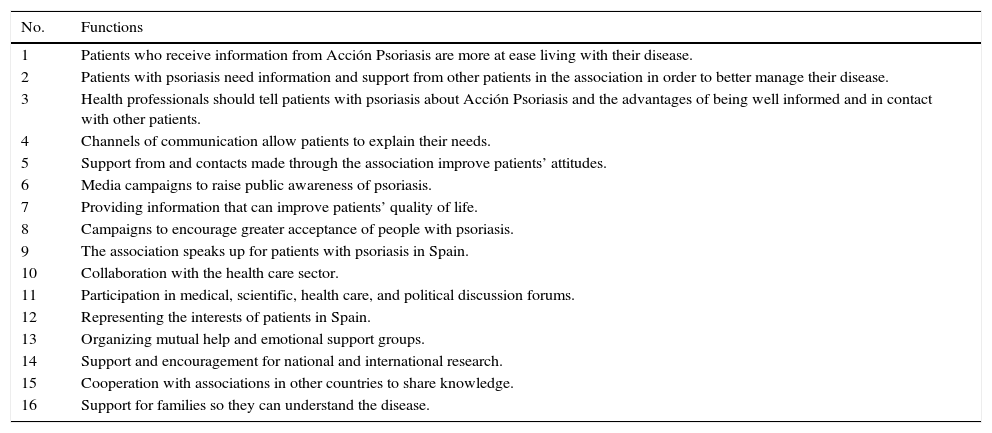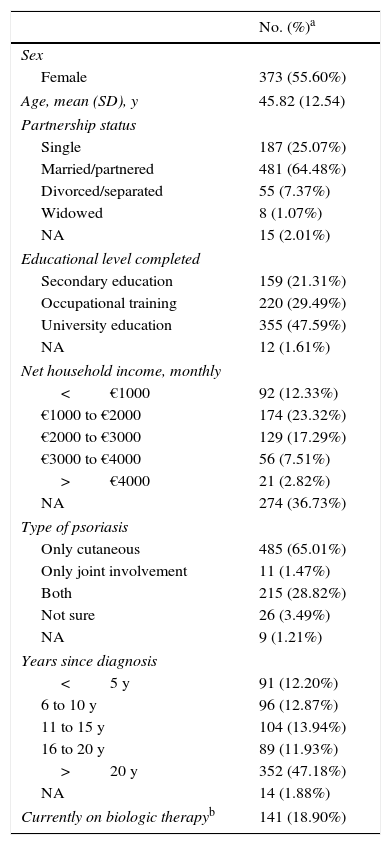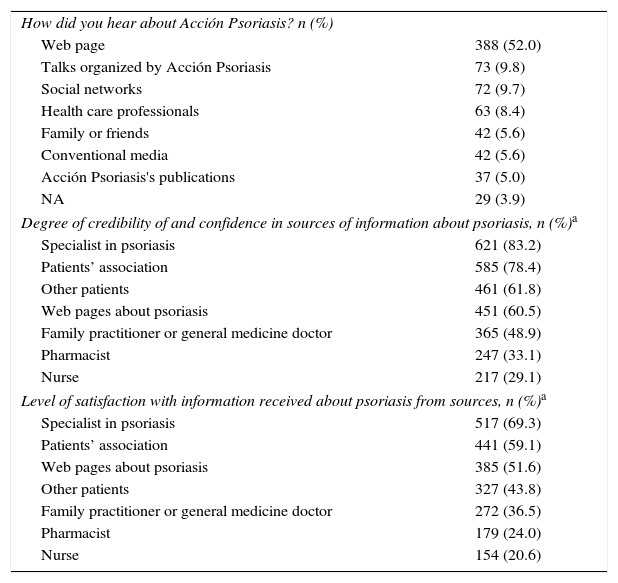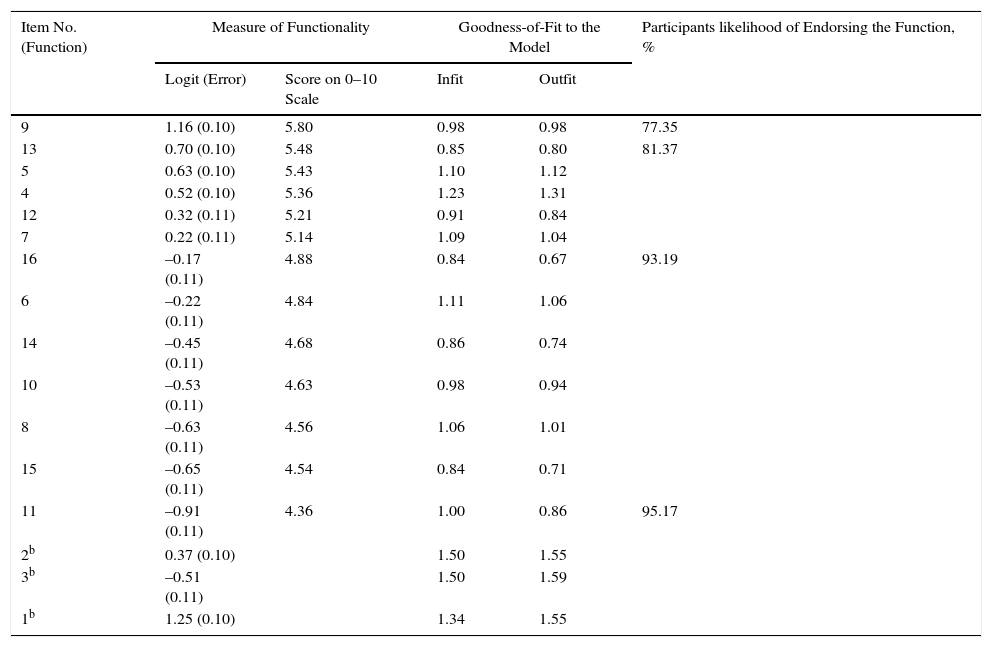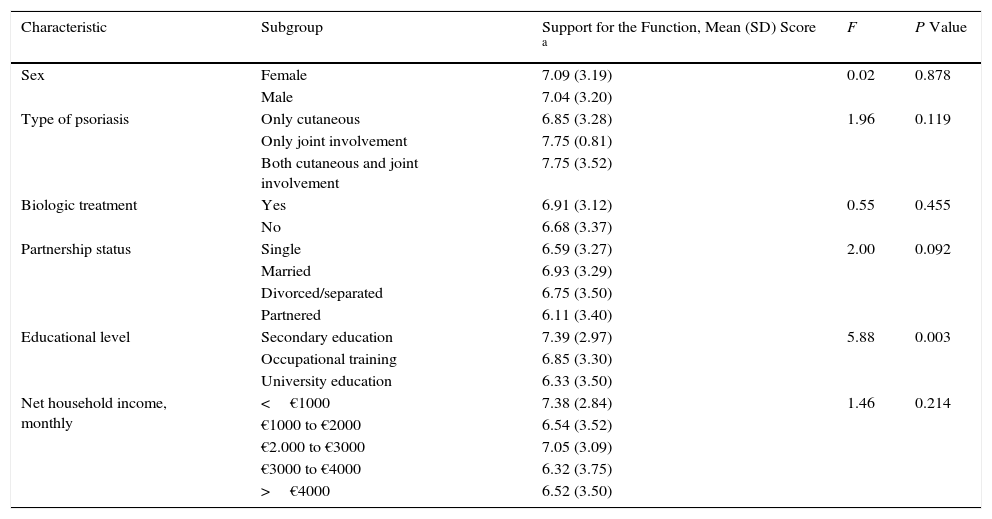Patient associations form part of health care systems, but little is known about how their members view the functionality of these associations and whether they endorse their goals and activities.
ObjectiveTo study how the members of the leading Spanish association of patients with psoriasis and their relatives view the group's functioning.
Material and methodsSurvey study using a self-administered questionnaire answered by members of the association (total membership, 26 349 persons). The credibility of the association and respondents’ confidence in and satisfaction with it were studied and compared with their attitudes toward other agents in the health care system. A Rasch model was used to analyze respondents’ ranking of functions. Analysis of variance was used to study between-group differences.
ResultsA total of 746 members participated (response rate 2.83%). The association's credibility was rated in second place, after that of specialists who treat psoriasis. Support for the association functions was good (7.53 on a scale of 0 to 10). The function the members rated highest was the raising of societal awareness of psoriasis and its problems. Rated lowest were functions related to personal services for members. Educational level was the only participant factor associated with significant differences in evaluations (P<.05).
ConclusionsThe psoriasis association contributes by disseminating information about the disease and patient care, and it serves to represent patients. Health professionals and institutions should take the association into account in their efforts to deal with the disease and in designing effective policies.
Las asociaciones de pacientes son un elemento más del sistema sanitario, sin embargo en España se desconoce la funcionalidad y el respaldo que tienen según sus propios asociados.
ObjetivoEstudiar la funcionalidad de la principal asociación española de pacientes y familiares afectados por la psoriasis según sus propios socios.
Material y métodosEstudio mediante un cuestionario autoadministrado a una muestra de socios y/o simpatizantes (población total=26.349 personas). Se estudió la credibilidad, confianza y satisfacción y se comparó con otros agentes sanitarios. El cuestionario de funcionalidad se analizó con un modelo de Rasch, y se examinó si había diferencias entre grupos de participantes con la prueba de ANOVA.
ResultadosParticiparon 746 socios y/o simpatizantes (tasa de respuesta 2,83%). La credibilidad de la asociación se situó tras la de los especialistas que tratan la psoriasis. El respaldo medio a la función de la asociación fue notable (7,53 en una escala de 0 a 10). Según los socios las funciones mejor puntuadas se relacionaban con acciones colectivas para sensibilizar a la sociedad sobre el problema de la psoriasis, en cambio, tuvieron una menor valoración las acciones relacionadas con los servicios de atención personalizada. Solo hubo diferencias significativas (p<0,05) en el respaldo a la asociación en función del nivel académico de los participantes.
ConclusionesLas asociaciones son unas instituciones que contribuyen a la difusión de información de la enfermedad, que cuidan y representan a los pacientes. Los profesionales de salud e instituciones deberían tenerlas en cuenta para afrontar la psoriasis y diseñar políticas de salud efectivas.
Patient associations are nonprofit groups that represent individuals with a health problem or specific disease. The only association for people with psoriasis in Spain that is affiliated with the International Federation of Psoriasis Associations is Acción Psoriasis. Founded in 1993, Acción Psoriasis currently has 36000 members (patients with the disease or interested relatives) and stands among the largest patient associations in Europe.1 The group's objectives are to improve medical care for patients with psoriasis, reduce the social stigma associated with the disease, and increase the number of scientific studies that serve to improve quality of life for those affected.2
The functions of patient associations have evolved over time. They initially served as support groups, providing mutual aid and encouragement. However, the needs patients themselves identified led them to organize additional services to provide support for families.3 Grants for research and arrangements for contact with institutions on behalf of those affected by a condition were other functions that were eventually added.4 In countries like the United States and the United Kingdom, these groups currently stand alongside health professionals and institutions when pushing for changes in policies and strategies.5 In Spain, however, the functions of groups like Acción Psoriasis have not been studied, and no hard data is available to confirm that members feel their activities truly help those affected by the disease. Members and friends of Acción Psoriasis were surveyed in 2014 in order to study how they view the association's functioning. Thus, the aim of this study was to analyze members’ perceptions of the association's societal role and determine whether or not they endorsed its functions.
Material and MethodsStudy DesignInformation for this cross-sectional study was gathered with a self-administered online survey. The target population consisted of the 26349 members or friends registered in the database of Acción Psoriasis. Members were sent an e-invitation with a link to the questionnaire. The completed questionnaires were analyzed between January and June 2014.
VariablesA multidisciplinary panel of experts on psoriasis (a dermatologist, a rheumatologist, a psychologist, and 3 members) developed the questionnaire on the association's functionality.
The main items under study concerned the functions of Acción Psoriasis and endorsement of its societal functions, as represented by the activities organized to meet the association's objectives. The questionnaire had 16 items, each of which made a statement about a function. Participants were asked to express whether they completely disagreed with the statement, partially disagreed, partially agreed, or completely agreed. Table 1 shows a brief summary of all 16 items. The survey also collected other secondary information, such as sociodemographic variables (sex, age, partnership status, educational level, and monthly net income). Also recorded were type of psoriasis and whether a biologic treatment was being followed (as an indirect indicator of severity). Items about the credibility of information and respondents’ confidence named the following sources: health care professionals, patient associations, psoriasis web sites, other patients, and conventional media. Answers to these last items were given on a 4-point scale reflecting levels of confidence: none, some, considerable, and a great deal).
Items on the Association Functionality Questionnaire.
| No. | Functions |
|---|---|
| 1 | Patients who receive information from Acción Psoriasis are more at ease living with their disease. |
| 2 | Patients with psoriasis need information and support from other patients in the association in order to better manage their disease. |
| 3 | Health professionals should tell patients with psoriasis about Acción Psoriasis and the advantages of being well informed and in contact with other patients. |
| 4 | Channels of communication allow patients to explain their needs. |
| 5 | Support from and contacts made through the association improve patients’ attitudes. |
| 6 | Media campaigns to raise public awareness of psoriasis. |
| 7 | Providing information that can improve patients’ quality of life. |
| 8 | Campaigns to encourage greater acceptance of people with psoriasis. |
| 9 | The association speaks up for patients with psoriasis in Spain. |
| 10 | Collaboration with the health care sector. |
| 11 | Participation in medical, scientific, health care, and political discussion forums. |
| 12 | Representing the interests of patients in Spain. |
| 13 | Organizing mutual help and emotional support groups. |
| 14 | Support and encouragement for national and international research. |
| 15 | Cooperation with associations in other countries to share knowledge. |
| 16 | Support for families so they can understand the disease. |
We calculated absolute and relative frequencies, expressing results for categorical variables as percentages and continuous variables as the mean (SD). For degree of credibility of, confidence in, and satisfaction with information received, we grouped responses in the 2 highest categories (“considerable” and “a great deal”) and reported the combined percentage.
A Rasch model for scales was used to analyze the responses for functionality. This model allows assessment of opinions that an item is problematic versus support for it.6 The goodness of fit of items in the model was checked with infit and outfit statistics, which should fall within the range of 0.7 to 1.4.7 If the statistics for an item fell outside that range, we considered removing it. Unidimensionality was tested by analyzing the percentage of individual t tests between 2 groups of items selected by principal components analysis of model residuals outside the range of ±1.96 SDs of the mean; we expected a maximum of 5% disagreement.
The logit, or unity setting, required by the Rasch model was transformed linearly to a scale of 1 to 10 to facilitate interpretation: 0 corresponded to the least degree of difficulty or perceived problem with a function and 10 to maximum difficulty for a function, which would imply that the participant felt that the association was not achieving that functional goal. Finally, we used analysis of variance to assess differences in the mean scores for respondents’ support for a function of the association. All analyses were performed with the Rasch Winsteps program (version 3.92.1)8 and SPSS (version 23, IBM).
ResultsA total of 26349 persons registered in the association's database were invited to respond; 854 (3.24%) at least partially completed questionnaires were returned and 746 could be analyzed, for a response rate of 2.83%. Questionnaires were excluded mainly because they were filled in by a patient's relative or others (health care professionals or administrative personnel). We also excluded returns from registered persons who did not reside in Spain.
A majority of the respondents (485 [65.0%]) only had cutaneous psoriasis, and 91 (12.2%) had been diagnosed within the past 5 years. Table 2 shows the descriptive statistics. Most respondents (460 [61.7%]) learned about the association on the Internet (from web pages or social networks) (Table 3). Table 3 also shows how the respondents ranked the credibility of information received from various sources and their confidence in those sources or satisfaction. In both cases (credibility and confidence/satisfaction), respondents awarded the highest rank to specialists; next came the association. Pharmacists and nurses ranked lowest.
Respondent Characteristics.
| No. (%)a | |
|---|---|
| Sex | |
| Female | 373 (55.60%) |
| Age, mean (SD), y | 45.82 (12.54) |
| Partnership status | |
| Single | 187 (25.07%) |
| Married/partnered | 481 (64.48%) |
| Divorced/separated | 55 (7.37%) |
| Widowed | 8 (1.07%) |
| NA | 15 (2.01%) |
| Educational level completed | |
| Secondary education | 159 (21.31%) |
| Occupational training | 220 (29.49%) |
| University education | 355 (47.59%) |
| NA | 12 (1.61%) |
| Net household income, monthly | |
| <€1000 | 92 (12.33%) |
| €1000 to €2000 | 174 (23.32%) |
| €2000 to €3000 | 129 (17.29%) |
| €3000 to €4000 | 56 (7.51%) |
| >€4000 | 21 (2.82%) |
| NA | 274 (36.73%) |
| Type of psoriasis | |
| Only cutaneous | 485 (65.01%) |
| Only joint involvement | 11 (1.47%) |
| Both | 215 (28.82%) |
| Not sure | 26 (3.49%) |
| NA | 9 (1.21%) |
| Years since diagnosis | |
| <5 y | 91 (12.20%) |
| 6 to 10 y | 96 (12.87%) |
| 11 to 15 y | 104 (13.94%) |
| 16 to 20 y | 89 (11.93%) |
| >20 y | 352 (47.18%) |
| NA | 14 (1.88%) |
| Currently on biologic therapyb | 141 (18.90%) |
Abbreviation: NA, not answered.
First Awareness of the Association, and Credibility of and Satisfaction With Information Received From the Association.
| How did you hear about Acción Psoriasis? n (%) | |
| Web page | 388 (52.0) |
| Talks organized by Acción Psoriasis | 73 (9.8) |
| Social networks | 72 (9.7) |
| Health care professionals | 63 (8.4) |
| Family or friends | 42 (5.6) |
| Conventional media | 42 (5.6) |
| Acción Psoriasis's publications | 37 (5.0) |
| NA | 29 (3.9) |
| Degree of credibility of and confidence in sources of information about psoriasis, n (%)a | |
| Specialist in psoriasis | 621 (83.2) |
| Patients’ association | 585 (78.4) |
| Other patients | 461 (61.8) |
| Web pages about psoriasis | 451 (60.5) |
| Family practitioner or general medicine doctor | 365 (48.9) |
| Pharmacist | 247 (33.1) |
| Nurse | 217 (29.1) |
| Level of satisfaction with information received about psoriasis from sources, n (%)a | |
| Specialist in psoriasis | 517 (69.3) |
| Patients’ association | 441 (59.1) |
| Web pages about psoriasis | 385 (51.6) |
| Other patients | 327 (43.8) |
| Family practitioner or general medicine doctor | 272 (36.5) |
| Pharmacist | 179 (24.0) |
| Nurse | 154 (20.6) |
The Rasch model analysis of opinions about functionality showed that items 1, 2, and 3 had outfit values outside the expected range. The scarce goodness of fit of these items in the model was attributable to their inclusion of 2 concepts in the wording. In accordance with the criteria established, they were eliminated from further analysis.
The high mean (SD) score of 7.53 (2.03) on the 10-point scale indicated strong support for the 13 association functions that could be analyzed. Item 11 (regarding participation in medical, scientific, health care, and political discussion forums) had the lowest difficulty score (4.36 on the 10-point scale), and 95.2% of the respondents considered that the association performed this function. Six other items (15, 8, 10, 14, 6, 16 in ascending order of perceived difficulty) had the support of 93.2% of the participants. These functions concern the association's representation of patients and interaction with groups and institutions. Items 13, 5, 4, and 12 were perceived to be the most problematic, or difficult, achieving scores higher than 5 on the scale. These items mainly refer to the association's personal services to members. However, even these activities or roles had the support of a majority, as they were endorsed by 81.4%. Item 9 (stating that the association speaks for patients with psoriasis in Spain) was perceived as the most problematic, or difficult; it received a score of 5.80 and was endorsed by 77.3% of the respondents. Table 4 shows the results for each item and the adjusted statistics.
Assessments of Perceived Difficulty of Functions, Ordered From Weakest Endorsement of the Function (Higher Score for Difficulty) to Stronger Endorsement (Lower Difficulty Score)a
| Item No. (Function) | Measure of Functionality | Goodness-of-Fit to the Model | Participants likelihood of Endorsing the Function, % | ||
|---|---|---|---|---|---|
| Logit (Error) | Score on 0–10 Scale | Infit | Outfit | ||
| 9 | 1.16 (0.10) | 5.80 | 0.98 | 0.98 | 77.35 |
| 13 | 0.70 (0.10) | 5.48 | 0.85 | 0.80 | 81.37 |
| 5 | 0.63 (0.10) | 5.43 | 1.10 | 1.12 | |
| 4 | 0.52 (0.10) | 5.36 | 1.23 | 1.31 | |
| 12 | 0.32 (0.11) | 5.21 | 0.91 | 0.84 | |
| 7 | 0.22 (0.11) | 5.14 | 1.09 | 1.04 | |
| 16 | –0.17 (0.11) | 4.88 | 0.84 | 0.67 | 93.19 |
| 6 | –0.22 (0.11) | 4.84 | 1.11 | 1.06 | |
| 14 | –0.45 (0.11) | 4.68 | 0.86 | 0.74 | |
| 10 | –0.53 (0.11) | 4.63 | 0.98 | 0.94 | |
| 8 | –0.63 (0.11) | 4.56 | 1.06 | 1.01 | |
| 15 | –0.65 (0.11) | 4.54 | 0.84 | 0.71 | |
| 11 | –0.91 (0.11) | 4.36 | 1.00 | 0.86 | 95.17 |
| 2b | 0.37 (0.10) | 1.50 | 1.55 | ||
| 3b | –0.51 (0.11) | 1.50 | 1.59 | ||
| 1b | 1.25 (0.10) | 1.34 | 1.55 | ||
Participants with lower levels of formal education tended to endorse the societal functions of Acción Psoriasis more firmly. However, even though the differences were statistically significant, they were not large in magnitude: the difference of 1.60 points on the 10-point scale between respondents with lower and higher levels of formal education cannot be considered important in practical terms. Neither age (r, 0.053; P=.146) nor other variables were associated with differences of opinion about the association's performance (Table 5).
Associations Between Respondent Characteristics and Opinions Expressed About Functionality.
| Characteristic | Subgroup | Support for the Function, Mean (SD) Score a | F | P Value |
|---|---|---|---|---|
| Sex | Female | 7.09 (3.19) | 0.02 | 0.878 |
| Male | 7.04 (3.20) | |||
| Type of psoriasis | Only cutaneous | 6.85 (3.28) | 1.96 | 0.119 |
| Only joint involvement | 7.75 (0.81) | |||
| Both cutaneous and joint involvement | 7.75 (3.52) | |||
| Biologic treatment | Yes | 6.91 (3.12) | 0.55 | 0.455 |
| No | 6.68 (3.37) | |||
| Partnership status | Single | 6.59 (3.27) | 2.00 | 0.092 |
| Married | 6.93 (3.29) | |||
| Divorced/separated | 6.75 (3.50) | |||
| Partnered | 6.11 (3.40) | |||
| Educational level | Secondary education | 7.39 (2.97) | 5.88 | 0.003 |
| Occupational training | 6.85 (3.30) | |||
| University education | 6.33 (3.50) | |||
| Net household income, monthly | <€1000 | 7.38 (2.84) | 1.46 | 0.214 |
| €1000 to €2000 | 6.54 (3.52) | |||
| €2.000 to €3000 | 7.05 (3.09) | |||
| €3000 to €4000 | 6.32 (3.75) | |||
| >€4000 | 6.52 (3.50) |
This is the first study to evaluate perceptions about the functioning of the main Spanish association for people with psoriasis and their families. The results show that the performance of Acción Psoriasis is good and it enjoys considerable support from its members. A finding that particularly stands out is the credibility of and satisfaction with the information members receive from the association.
The functions the respondents endorsed most were related to activities to raise societal awareness of psoriasis and build bridges with other agents in the health care sector. Such functions are necessary for designing strategies for societal change that favor people with psoriasis. Patient associations in the United States explain patients’ points of view in debates, thus helping health care institutions and professionals, the pharmaceutical industry, and scientific associations to improve their efficiency.9,10 Functions whose performance received less support from the respondents were those that provided psychological or social support for members. Such functions are usually performed by professionals in health care centers in Spain, although patient associations become involved in other countries without leading to duplication of services.11 Closer ties between professionals and associations benefit patients directly, facilitating information transfer and improved management of the feelings that arise in relation to the stigma of psoriasis.12
The high opinions regarding the credibility of, confidence in, and satisfaction with the association expressed by large percentages of respondents suggest that our survey is robust. An unexpected finding was the relatively low assessment of the credibility of and satisfaction with family practitioners, pharmacists and nurses as sources of information; these groups were ranked below web pages and other patients. This finding suggests that although psoriasis is a highly prevalent disease—affecting 2.30% of the Spanish population13—these sources may not be providing the type of information about treatment and disease management that patients need. We think that nurses could take on a more active role in health care centers. In contexts where patient care is given by multidisciplinary teams, nurses can help patients approach psoriasis treatments effectively.14,15 An example of this type of program can be found in an intervention organized by the care team of Acción Psoriasis.16
A limitation of this study is the low response rate. From a total population of 26349, we received 746 responses that could be analyzed (2.83%), potentially affecting the accuracy of our estimates. However, the Rasch model has been shown to be very robust in simulations with small samples; although estimates of difficulty and endorsement might vary somewhat, their ranking does not.17 We therefore believe that if we had received a larger number of responses, the ordering of functions considered difficult to achieve would have remained the same. The results of this study can be applied to persons (patients and sympathizers) who are registered in the Acción Psoriasis database, not to all people with psoriasis. We believe the results reflect the true opinions of this group toward the functions performed by the association.
Ethical DisclosuresProtection of human and animal subjectsThe authors declare that no experiments were performed on humans or animals for this investigation.
Data confidentialityThe authors declare that no private patient data are disclosed in this article.
Right to privacy and informed consentThe authors declare that no private patient data are disclosed in this article.
Conflicts of InterestLuis González-de Paz has received fees related to research from Acción Psoriasis.
Miquel Ribera has received grants and payments related to research, consulting, and training from the following companies: Abbvie, Gebro Pharma, Janssen, Leo Pharma, MSD, Novartis, and Pfizer. He is currently a scientific consultant for Acción Psoriasis.
Jordi Gratacós-Masmitjà has received grants and payments related to research, consulting, and training from the following companies: Abbvie, Janssen, MSD, Novartis, and Pfizer. He is currently a scientific consultant for Acción Psoriasis.
Sandra Ros has received grants and payments related to research from Abbvie, Pfizer, Janssen, and Novartis. She is currently a scientific consultant for Acción Psoriasis.
Carles Blanch Mur is a full-time employee of Novartis Farmacéutica S.A.
Santiago Alfonso-Zamora is the manager of Acción Psoriasis.
Please cite this article as: González-de Paz L, Ribera M, Gratacós-Masmitjà J, Ros S, Blanch Mur C, Alfonso-Zamora S. Función y respaldo a la asociación de pacientes con psoriasis en España según sus miembros: estudio descriptivo transversal. Actas Dermosifiliogr. 2016;107:751–757.

